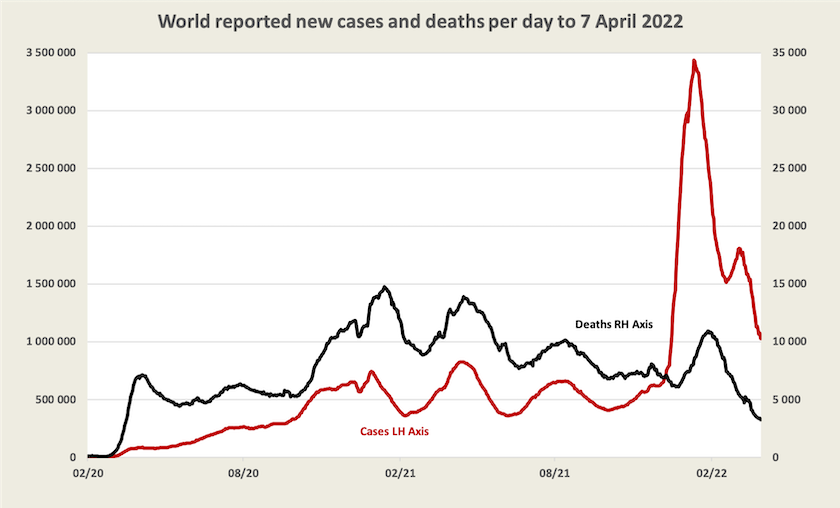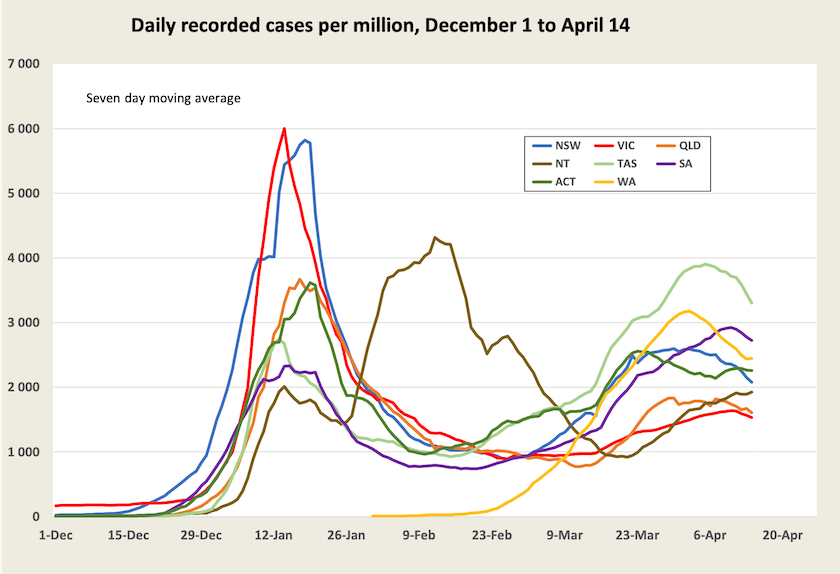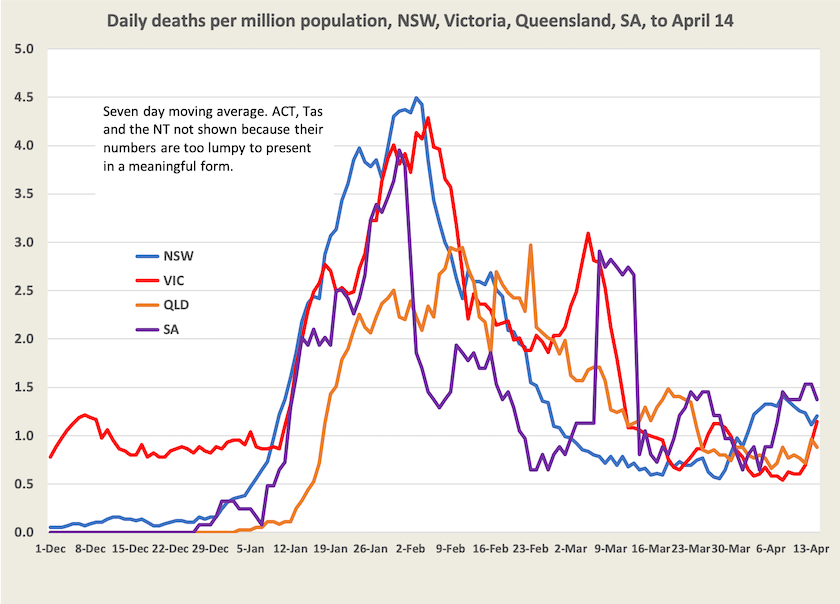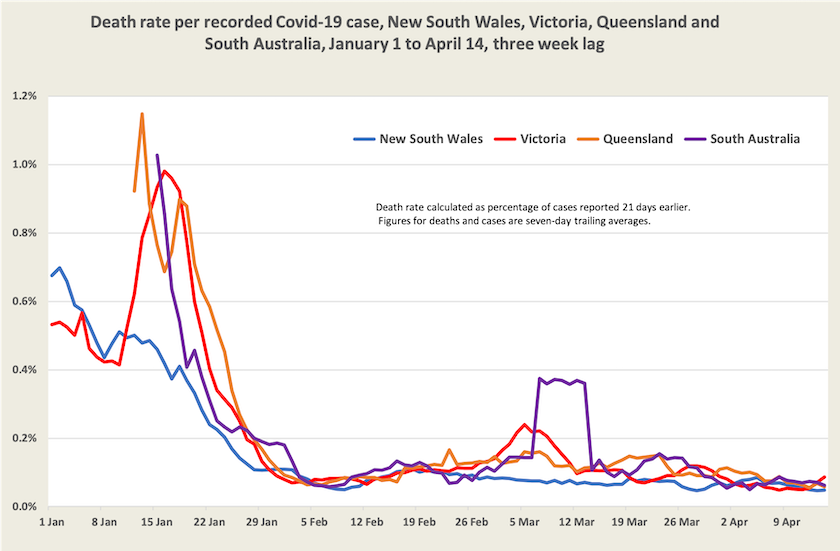The pandemic – maybe this wave has peaked
Worldwide – reported cases and deaths falling
The latest WHO epidemiological update (April 12) reports that cases and deaths in all major regions are falling.

These are officially-reported cases and deaths, and even in “developed” countries with good reporting systems many cases would be unreported, although death figures wold be more accurate.
On the latest Coronacast Norman Swan mentions research that attempts to estimate the actual number of cases worldwide, including in Africa where there is little reporting. That research estimates that until November last year 3.39 billion people had been infected, while official WHO figures recorded only 0.25 million infections.
The Economist has an infographic on excess deaths by country. That is, deaths not recorded but estimated by inference by subtracting total deaths during the pandemic from statistically estimated deaths projected from past records, with a few other tweaks. Russia and Ukraine stand out with a high number of excess deaths (these are pre-war estimates), but the article gives little coverage of Africa, presumably because regular death data is hard to come by. Its daily excess death tracker, protected by a paywall, estimates that there have been 24 million deaths worldwide, compared with 6 million on WHO records.
Nevertheless, even if there is a huge bias in reporting, provided that bias is unchanged (i.e. that there is a generally constant relationship between reported and unreported cases) cases and deaths are falling. Swan reminds us, however, that the present variant is no less deadly than the original Wuhan variant: that means those promising figures would be the result of better vaccination, better public health measures, and better treatments. The unvaccinated and inadequately vaccinated still face a high risk of severe illness or death.
At present reported cases are concentrated in western Europe and in “developed” countries in east Asia, including Australia, but China is still not showing up in these gross figures. In China cases are now around 25 000 a day – around the rate in New South Wales on a bad day – but in China cases are doubling every week in an established pattern of exponential growth, which, if sustained, will see the whole population infected by July.
That’s the main issue addressed in the same Coronacast, which carries the heading “How long can any country stay COVID zero?”. We have heard about the extraordinary measures employed in Shanghai (and now in many other cities) to try to contain the virus, but while there is strong exponential growth of infections it’s fairly clear to all, apart from Chinese officials pursuing some other agenda, that like New Zealand, Singapore and Australia, China will have to give up its zero Covid aspiration.
Britain’s BBC has a 4-minute video Shanghai lockdown: What could China’s zero Covid policy mean for the world economy?. The global economic effects could be substantial, and China could suffer high death rates because while its overall vaccination rates are high, it has not prioritized the old and frail. Attracting less attention is Taiwan, where cases are now rising strongly from a small base. Because it is so connected to world markets, there could be significant consequences for the world economy.
Australia – promising figures, but are we too hasty in removing mandates?
We could have done much better
In the election campaign Morrison has been prattling on about “40 000 lives saved”. Paul Karp, writing in The Guardian, provides a polite criticism of this absurd number. We have had only 6 600 total Covid deaths, which in relation to our population is certainly low in comparison with the OECD average, but the OECD includes Mexico, the USA and the UK, that have had appalling numbers, while we have had the benefit of living on an island – girt by sea – and with reasonably separate population centres.
More relevant to evaluation of our performance is the number of those 6 600 deaths we could have avoided through a little foresight and better management, particularly in relation to nursing homes and our indigenous population, and had the Morrison government not been unnecessarily tardy in buying mRNA vaccines. Also, 4 400 of those 6 600 deaths have occurred this year, in 2022. Many of these could have been avoided had Morrison not been so gung-ho in pressuring New South Wales to “open up” before Christmas.
Little publicity has been given to the final report of the Senate Select Committee on COVID-19, presented on April 7. It’s mainly a set of recommendations aimed at preparedness for future epidemics and calling for more openness. Its main recommendation is that the Commonwealth government “establish an Australian Centre for Disease Control to improve Australia’s pandemic preparedness, operational response capacity, and communication across all levels of government”.
But it also recommends “that a Royal Commission be established to examine Australia's response to the COVID-19 pandemic to inform preparedness for future COVID-19 waves and future pandemics”.
To quote the report’s main findings:
To date, the Australian Government's response has been characterised by poor preparation, a refusal to take responsibility and provide national leadership – including in areas of clear Commonwealth constitutional responsibility – a failure to learn lessons as the pandemic progressed, and significant failures of implementation with, at times, catastrophic consequences.
Throughout the pandemic, the Australian Government side-stepped its responsibility for the quarantine system, which left the country vulnerable to outbreaks, lockdowns, and widespread community transmission.
The government has also failed to address the serious and dangerous vaccine misinformation promoted within the government's own parliamentary ranks.
The committee has been prevented from building a full picture of what the government knew, when, what advice it received and from whom, what decisions it made and how effective these decisions were in responding to different waves of the outbreak.
The pandemic’s current wave
In all states, even in Western Australia, the number of cases being reported daily seems to have peaked: only in the ACT and the Northern Territory is there yet to be firm evidence of a decline. The apparent fall in cases could be a result of fewer people reporting to authorities, but it would be surprising if that would be happening in all six states at the same time.

If these reductions in case numbers are real, we should expect to see a fall in the number of deaths each day in the coming weeks, but for now deaths are still around 1.0 per day per million in those states where the latest wave Covid-19 was established earliest.

While the number of deaths is not falling – because cases were still rising a few weeks ago – the number of deaths per case is falling. In the latest week between one in a thousand and one in two thousand cases of a recorded Covid-19 infection is followed by death. That’s still high.

This improving trend is reinforcing pressure for various mandates and restrictions to be lifted, but to an extent these figures are a result of our having maintained some level of public health measures. Writing in The Conversation Katie Atwell of the University of Western Australia warns: Time to remove vaccine mandates? Not so fast – it could have unintended consequences.